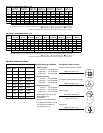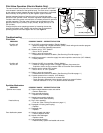
Servicing Pilot Valve
Note: Refer to Figure 16 for the following procedure.
1. Make sure that the water supply to sprinkler is positively
shut off and any residual pressure has been bled off. If
the sprinkler is pressurized, main valve will open when
the pilot valve is disconnected from control tube.
2. Carefully remove turf and soil from the side of the
sprinkler to expose pilot valve and control tubing.
3. Remove the two retaining screws from the pilot valve
housing.
4. Pull the pilot valve assembly away from the sprinkler
body and cut the control tubing just below tube retainer.
Unless pilot valve has been previously removed, control
tubing length will be sufficient for re-connection.
5. Remove tube retainer and remaining piece of control
tubing from valve body fitting.
6. Remove the solenoid (1 or 2) by turning it
counterclockwise.
7. Remove the retaining nut (17) and washer (18) from the
pressure adjuster (10) and pull the pilot valve body
assembly out of housing (14).
8. Remove diaphragm assembly (14), piston (13), spring (12), traveling adjuster (11), pressure adjuster (10) and o-ring (6).
9. Remove selector shaft assembly (8) and plunger assembly (4). (The selector shaft retains the plunger in the valve body.)
10. Thoroughly clean and inspect all parts. Replace damaged parts as necessary and reassemble in reverse order.
Note: Refer to Illustrated Parts Breakout Book, form number 368-0044 for service part numbers.
Flushing Sprinkler ________________________________________________________________
1. With sprinkler operating, carefully step down on center of cap several times. Water will flow around riser and flush out debris.
2. Cycle sprinkler on and off several times to check for proper retraction. Cap should be even with top of body flange when fully
retracted. If riser sticks in up position, check for debris lodged between riser and body. Flush out all debris. Remove sprinkler
mechanism if necessary.
© 2004 The Toro Company, Irrigation Division Form Number 373-0278 Rev. A
1
2
4
6
5
3
7
8
15
16
17
10
11
12
13
14
9
Figure 16
WARNING
NEVER STAND OR LEAN OVER THE SPRINKLER WHILE THE IRRIGATION SYSTEM IS BEING FILLED, DURING
MANUAL OR AUTOMATIC OPERATION OR WHEN PERFORMING SPRINKLER SERVICE PROCEDURES. DIRECT
CONTACT WITH IRRIGATION SPRAY, A FAILED OR IMPROPERLY INSTALLED SPRINKLER CONNECTION OR
SPRINKLER COMPONENTS FORCIBLY EJECTED UPWARD UNDER PRESSURE CAN CAUSE SERIOUS INJURY.
WARNING
NEVER STAND OR LEAN OVER THE SPRINKLER WHILE THE IRRIGATION SYSTEM IS BEING FILLED, DURING
MANUAL OR AUTOMATIC OPERATION OR WHEN PERFORMING SPRINKLER SERVICE PROCEDURES. DIRECT
CONTACT WITH IRRIGATION SPRAY, A FAILED OR IMPROPERLY INSTALLED SPRINKLER CONNECTION OR
SPRINKLER COMPONENTS FORCIBLY EJECTED UPWARD UNDER PRESSURE CAN CAUSE SERIOUS INJURY.












